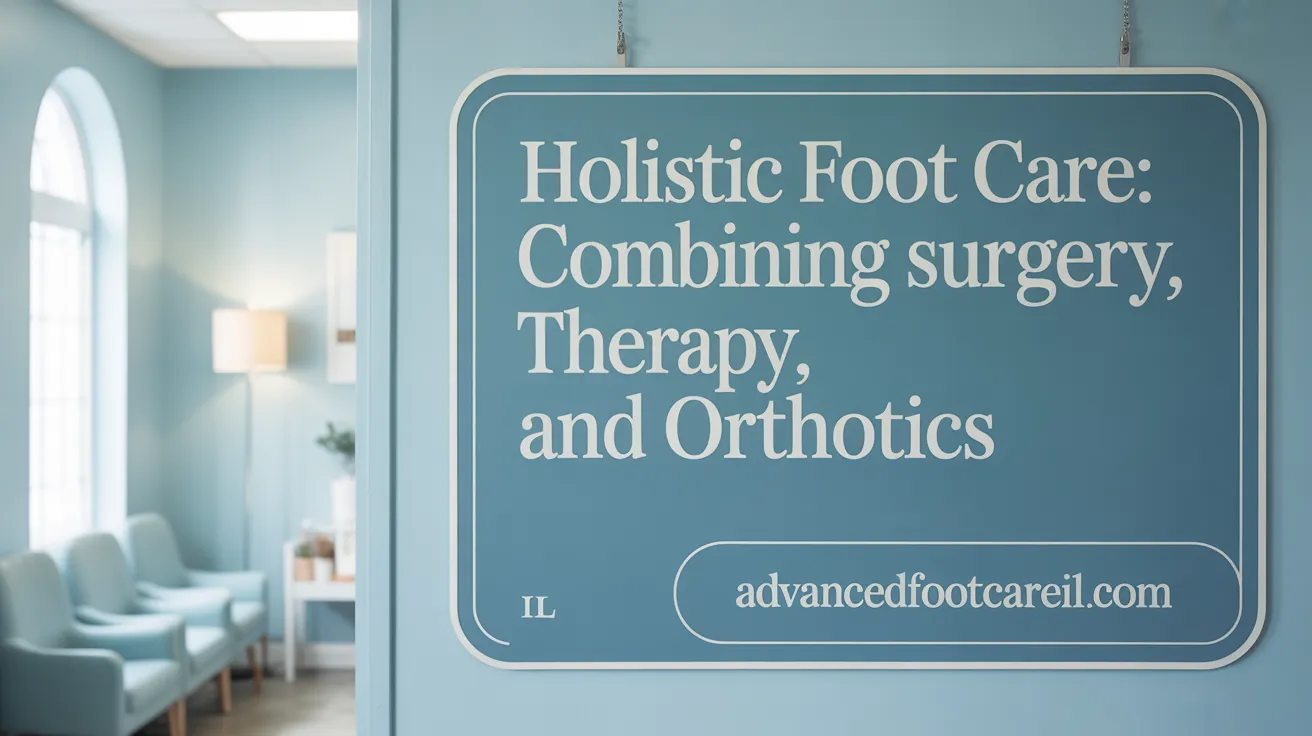The Transformative Power of Expert Foot Care
Foot health is integral to overall well-being, mobility, and quality of life. Across diverse patient experiences, expert foot care—ranging from surgery to conservative management and education—has consistently transformed lives. This article uncovers real patient testimonials that illuminate journeys of overcoming debilitating pain, regaining activity, and embracing renewed independence through professional foot and ankle care.
Breaking Barriers: Transformative Surgical Success Stories

How have complex surgeries transformed patient lives?
Complex surgeries have profoundly impacted patients suffering from severe foot deformities and chronic pain. For instance, Cherylyn Rogers' chronic foot pain story endured debilitating pain due to congenital deformities, arthritis, and multiple failed surgeries. After undergoing comprehensive foot surgery treatment plan including revision surgeries for foot correction and bone grafting in foot surgery under the care of Dr. Albert D'Angelantonio foot specialist, she experienced significant relief. Her mobility improved drastically, allowing her to wear normal shoes and participate actively in daily life.
Similar transformations are seen in patients like Paris Berry's Bunion Surgery Recovery, a former figure skater who corrected bunion deformities through two surgeries, and Russell, who overcame severe foot deformities and plantar fasciitis with reconstructive surgery as detailed in Russell's Reconstructive Foot Surgery. These interventions enabled them to return confidently to physical activities, family engagements, and professional commitments.
What are some notable patient recovery experiences following surgery?
Patient stories reveal encouraging recovery journeys post-surgery. Marlene's Foot Surgery Recovery, after two foot surgeries, resumed physical activities such as working out, playing softball, and roller skating. Steven Makowski's Foot and Ankle Treatment, who suffered from severe shooting foot pain, was able to walk comfortably after his specialized surgery. Dottie Miller's Ankle Replacement Decision, despite her age of 79, pursued ankle replacement surgery and restored her mobility.
These recoveries highlight the substantial improvements in quality of life foot and ankle surgeries can facilitate. They not only relieve pain but also restore independence, enabling patients to engage fully in work, sports, and family life.
Overview of Foot Surgeries Impact
| Surgery Type | Patient Example | Outcome Description |
|---|---|---|
| Revision Surgery | Cherylyn Rogers | Pain relief, restored mobility, normal shoe wear |
| Bunion Correction | Paris Berry | Return to active lifestyle, sport participation |
| Reconstructive Surgery | Russell | Walking ability restored, significant pain reduction |
| Ankle Replacement | Dottie Miller | Mobility restored despite advanced age |
| Multiple Foot Surgeries | Marlene | Return to diverse physical activities |
Surgical intervention for complex foot issues is proving transformative, offering renewed hope and improved daily function to many patients.
Comprehensive Care: Integrating Surgery, Physical Therapy, and Orthotics

Role of physical therapy post-foot surgery
Physical therapy is essential in recovery following foot surgery. After surgical interventions like bunion correction or plantar fasciitis treatment, physical therapists guide patients through exercises and stretches to restore mobility, reduce pain, and improve strength. Consistent participation in therapy helps patients regain function and return to activities such as sports or daily walking more quickly, contributing greatly to successful outcomes.
Non-surgical treatments for foot conditions
Many foot problems benefit from non-surgical approaches including cortisone injections, physical therapy, and orthotic support. For example, patients suffering from plantar fasciitis often achieve significant pain relief with a combination of targeted injections, proper footwear, and therapeutic exercises, avoiding or delaying surgery.
Use of orthotics and patient education in foot health
Customized orthotics play a vital role in managing foot conditions by providing cushioning, support, and pressure redistribution. Patient education complements orthotic use, with guidance on appropriate footwear, daily foot care routines, and symptom monitoring. Educated patients are more likely to adhere to care plans and recognize early signs of complications, which improves long-term foot health.
Patient satisfaction with multidisciplinary approaches
Multidisciplinary care involving surgeons, physical therapists, and orthotists delivers comprehensive treatment that addresses complex foot conditions effectively. Patients report high satisfaction due to improved pain levels, mobility, and understanding of their condition through clear communication and education. Clinics incorporating these holistic strategies, such as the practice in Matawan, NJ, demonstrate excellent clinical outcomes and positive patient experiences.
How does multidisciplinary care enhance foot health outcomes?
Combining surgery with physical therapy, orthotics, and education leads to effective recovery. For example, patients treated for plantar fasciitis benefit from cortisone injections, customized orthotics, and prescribed exercises that facilitate return to physical activities. The clinic experiences in Matawan, NJ showcase how holistic approaches, including patient education on footwear and foot care, improve outcomes and satisfaction.
Diabetes and Foot Care: Preventing Complications Through Education and Early Intervention

What role does education and regular exams play in managing diabetic foot health?
Education and regular examinations are crucial in managing foot health among diabetic patients. Studies show that foot care education significantly boosts patients’ ability to care for their feet properly and increases their confidence in managing their condition. Regular foot exams help detect issues early, preventing progression to ulcers or infections.
Why are regular diabetic foot exams important?
Yearly comprehensive foot exams by podiatrists or healthcare providers play a vital role in early detection of diabetic foot complications like neuropathy, poor circulation, and foot deformities. These exams include checking sensation, circulation, foot structure, and skin condition. Early intervention helps avoid severe outcomes such as ulceration and amputation.
What preventative foot care behaviors should diabetics adopt?
Patients with diabetes should follow these preventive behaviors:
- Daily foot inspection for cuts, blisters, or ulcers
- Keeping feet clean and moisturized (avoiding between toes)
- Cutting toenails straight across
- Wearing well-fitting shoes and socks consistently
- Avoiding walking barefoot
- Reporting any signs of foot problems promptly to their healthcare provider
For more detailed guidance, see foot care tips for diabetics.
What challenges hinder diabetic foot care?
Barriers include lack of patient awareness about the seriousness of foot health, emotional distress related to diabetes, financial or transportation constraints, and limited access to specialized foot care. Patients may also hold misconceptions, such as treating symptoms only when painful or neglecting daily care when asymptomatic. These challenges underline the importance of continuous education and supportive care.
How have patient stories illustrated success in diabetic foot management?
Roger Tuck, an engineer and grandfather, developed an infected diabetic foot ulcer after a minor injury. Thanks to a coordinated team approach including podiatry, endocrinology, and home care nursing, Roger healed fully within months. His story highlights the impact of multidisciplinary care and education in successful diabetic foot ulcer management.
| Aspect | Detail | Impact |
|---|---|---|
| Education | Improves self-care behavior and self-efficacy (source) | Better prevention and management of foot complications |
| Regular Exams | Early detection of neuropathy, ulcers, circulation problems (source) | Prevents severe infections and reduces amputation risk |
| Preventative Behaviors | Daily inspection, proper hygiene, footwear adherence (source) | Minimizes risk of injury and infection |
| Barriers | Emotional, socioeconomic, access issues (source) | Hinder consistent foot care and increase complication risk |
| Patient Success Story | Roger Tuck’s coordinated multi-disciplinary care (source) | Illustrates effective healing and quality of life improvement |
Patient-Centered Clinics: Compassion, Expertise, and Lasting Trust
How do patient experiences reflect the quality of foot care services?
Patient testimonials and experiences provide invaluable insight into the quality of foot care services. Clinics known for compassionate communication and expertise, such as the practice of Dr. Berenter and Beaver Valley Foot Clinic, consistently earn high patient satisfaction ratings. Patients praise professional and friendly staff who make them feel understood and cared for throughout their treatment journey.
Clear explanations about diagnoses and procedures help patients comprehend their conditions and empower them to participate actively in their care. Friendly, clean environments contribute to comfort and trust during visits, positively influencing treatment adherence.
Technological advances also play an important role in enhancing patient experience. Facilities using innovative treatments such as laser therapy for toenail fungus or Extracorporeal Shockwave Therapy (ESWT) for heel pain offer patients less painful, efficient solutions, encouraging positive outcomes.
Long-term patient-clinic relationships demonstrate trust and consistent quality. Clinics accepting a broad range of insurance plans and offering flexible scheduling improve accessibility, enabling ongoing foot health management.
Together, compassionate communication, clinical expertise, advanced technology, and accessible care environments create patient-centered foot care clinics characterized by lasting trust and excellent outcomes.
Innovations and Challenges in Foot Care Education and Promotion
What are current trends and challenges in foot care education?
Foot care education programs have gained attention for improving foot self-care behaviors and knowledge, particularly among older adults and individuals with diabetes. These programs often employ health promotion models based on self-efficacy theory and use various teaching methods—from group education to individualized advice and the provision of foot care equipment.
Despite their popularity and positive effects on self-care practices, the evidence supporting improved clinical outcomes such as reduced ulcer rates or enhanced quality of life remains inconclusive. The lack of standardized intervention designs and varying outcome measures across studies hamper the ability to draw firm conclusions.
Psychosocial and family factors play a vital role in adherence. For example, diabetes distress and emotional challenges can undermine self-care routines, while family involvement often supports consistent foot inspection and care. However, cultural norms and misconceptions about foot health sometimes act as barriers to optimal foot care.
Emerging strategies include technologically advanced tools like temperature-sensing socks to detect early signs of diabetic foot complications and the use of telemedicine for remote education and monitoring, enhancing accessibility and timely intervention.
Moving forward, a crucial gap remains: the development and implementation of theory-driven, standardized education and promotion programs tailored to diverse populations. Integrating psychosocial support and leveraging technology holds promise for enhancing foot care adherence and clinical results. For more details on these therapies and research approaches, see Health promotion models for footcare and foot care education for diabetes patients.
Foot Care: A Pathway to Renewed Life and Wellness
Real patient testimonials reveal the profound impact of expert foot care on restoring mobility, reducing pain, and enhancing quality of life. Whether through complex surgeries, comprehensive treatment approaches, or preventive foot care education—especially for vulnerable populations such as diabetics and older adults—foot health interventions enable people to regain confidence and independence. Continued advancements and patient-centered care promise even greater success in transforming lives through foot health.
